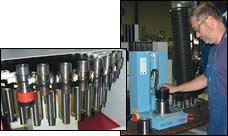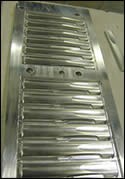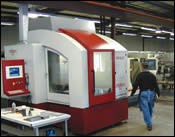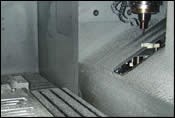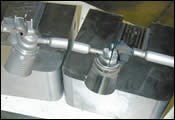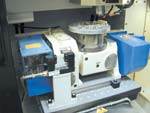Mold Machining And Beyond
Adopting high speed machining entailed some surprises. One of the surprises was an unforeseen opportunity for new work.
Share




Two years ago, D & M Tool Corporation of Springville, Indiana, decided to invest.
It wasn’t an easy decision. The shop’s business is primarily injection mold making, the largest share of which is devoted to serving automotive suppliers. Business was weak 2 years ago, with no prospect of getting better soon. But the company decided to move forward anyway, using the slow period as an opportunity to improve the shop’s capabilities before demand picked up again. D & M bought a 36,000-rpm high speed machining center that is easily the most sophisticated machine tool the shop has ever owned. This is the story of that investment.
This is also the story of the investment that came right after that. The financial investment was followed by an investment of attention and time. The shop learned how to apply high speed machining effectively. It did this almost solely through trial and error, learning some lessons applicable to this machine and this shop that might not apply to every use of a high-rpm machine.
The most important result of all of this effort has been the realization of a better process for machining molds. D & M takes light finish cuts at high feed rates in hardened steel to efficiently produce fine finishes and intricate details. Manual finishing, with its long delay and high labor content, has been dramatically reduced. And the role of EDM, once used for finish machining of entire mold forms, now has been focused, so that EDM today is used just to produce those details that aren’t practical to mill.
But then there is a second result of the investment in high speed machining, and the full significance of this result has yet to be determined. The knowledge the shop acquired proved to be transferable to an entirely different machining challenge. Just by committing to the development of this new capability, the shop found the way to an opportunity that it otherwise might never have seen.
Protect The Tool
The high speed machining center comes from Roeders of America (Orangeburg, New York). Mike Baker is a CAD/CAM programmer who is one of the shop’s primary users of this machine. He says the shop was fully prepared to purchase a machine from another builder, but it looked at the Roeders unit essentially because the salesman was persistent. With a higher top rpm, this latter machine promised to let the shop commit to high speed machining even more aggressively. In addition, the machine seemed to be more specifically designed for high speed milling of intricate dies and molds.
Another impressive feature, and one that has proven to be particularly significant to this shop, is non-contact tool setting. The tool passes through a laser while rotating at its full machining speed. The tool offset measurement thus precisely takes account of small runout values, as well as any slight shift in the set of the tooling or the spindle that might be the result of high-rpm rotation.
“Protect the tool” summarizes most of what Mr. Baker has learned about devising effective high speed machining processes. Along with the machine tool, the shop purchased a shrink-fit system that is dedicated to this machine. Shrink-fit toolholders provide rigid, low-runout clamping of the tool. Mr. Baker augments this benefit by taking care to program so that the tool is prevented from dwelling in the work.
“Don’t let the tool stop,” he advises. When the tool dwells, it rubs. At high rpm, this rubbing rapidly leads to wear. So he devises tool paths to minimize any slowing or pausing of the tool, using CAD/CAM software from Cimatron (Novi, Michigan).
One consequence of all of the measures taken to protect the tool is that the shop’s investment in tooling has proven to be less than expected.
“When we first got the machine, everyone sent us tooling to try—high-dollar stuff,” Mr. Baker says. However, the machine and the shrink-fit tooling together provide for very stable machining. The non-contact tool measurement accounts for variations resulting from runout, centrifugal force and inconsistency from tool to tool. And Mr. Baker is careful in his programming. Thanks to the combination of all of these factors, economical tools have performed better than the shop expected. In large part, the “high-dollar stuff” has not been required.
Machine It Like A Mold
“The accuracy is what really amazed us,” says Bill Maddox, D & M Tool’s vice president. Prior to purchasing the high speed machine, the shop’s fastest machining center was 10,000 rpm. That milling could hold such tight dimensional and surface finish tolerances was one thing, he says, but holding that quality at feed rates so much higher than what the shop was accustomed to was something else altogether. When the shop began to master the use of light milling passes at high feed rates, it was able to produce complex parts both faster and better at the same time.
But what about simpler parts?
D & M Tool’s parent company—Specialty Manufacturers, in Indianapolis—has various customers in the medical industry. One of these companies had a pressing need for machining work related to an initial production run of a new surgical device under development. D & M Tool took the job, even though the work was production machining instead of mold making. But how could the high speed machining center be used to deliver this work quickly and cost effectively?
The answer was to turn the job into a mold—sort of.
More accurately, the answer was to allow a batch of parts to become a single, complex part, produced using a long milling routine.
Each distinct part by itself may be geometrically simple. But nesting 10 or more pieces within a single block allows the shop to take advantage of the machining center’s ability to mill complex forms at high feed rates accurately. It’s just that the capability is now applied to a batch instead of a single core or cavity. Jobs the shop has run like this have tended to be aluminum, permitting feed rates of 750 ipm. The very last step in such a machining cycle is for a small end mill to cut each individual piece away from the nested block.
The Next Learning Curve
The shop has done work like this for three customers so far, and it is still learning. This time, the learning curve doesn’t relate to technology, but instead relates to the commercial aspects of the work. Often the shop does not know how well its quotes to customers compare with those of more typical job shops. Even so, it has become clear to the shop that the high speed machining center, along with the shop’s experience at applying it, represents an effective system for delivering these small-batch parts very rapidly.
There is an irony here. D & M Tool, like other U.S. mold makers, struggles against competition from mold makers using cheaper labor overseas. But now, with this opportunity the shop has found, it may be able to supplement its mold machining by landing some machining jobs that are needed too urgently for shipment across the sea.
Related Content
How to Accelerate Robotic Deburring & Automated Material Removal
Pairing automation with air-driven motors that push cutting tool speeds up to 65,000 RPM with no duty cycle can dramatically improve throughput and improve finishing.
Read MoreRead Next
Standard Jobs Beyond Standard Speed
This job shop is defining the role of extremely high spindle speed in variable-volume, variable-part-number production.
Read More5 Rules of Thumb for Buying CNC Machine Tools
Use these tips to carefully plan your machine tool purchases and to avoid regretting your decision later.
Read MoreSetting Up the Building Blocks for a Digital Factory
Woodward Inc. spent over a year developing an API to connect machines to its digital factory. Caron Engineering’s MiConnect has cut most of this process while also granting the shop greater access to machine information.
Read More













